The Pied-billed Grebe (Podilymbus podiceps) stands as a distinctive and adaptable waterbird, captivating birdwatchers with its unique characteristics.
Renowned for its cryptic plumage and stout, banded bill, this species boasts a diverse geographical presence throughout the Americas.
Found in various aquatic habitats, from northern Canada to southern Chile and Argentina, the Pied-billed Grebe showcases remarkable adaptability to diverse climates.
Notably, its name is derived from the distinctive black band encircling its bill during the breeding season.
Beyond its physical traits, the grebe’s behavioral nuances, including skilled diving for prey and elaborate courtship displays, contribute to its appeal.
As a testament to its versatility, the Pied-billed Grebe occupies a spectrum of wetland environments, embodying resilience and resourcefulness in the ever-changing landscapes it calls home. So, stay focused.
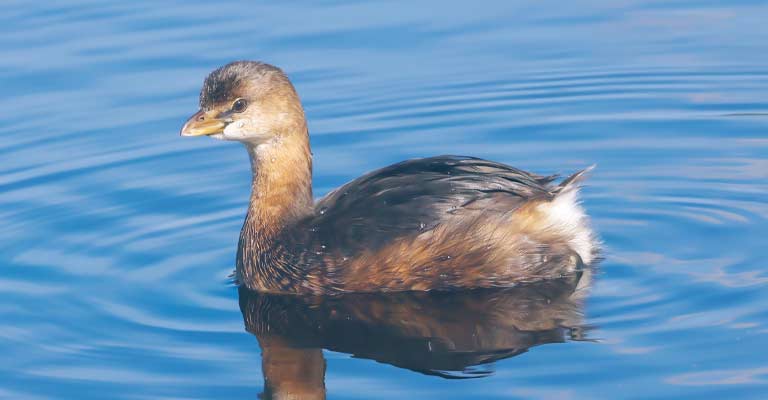
Pick Out Criteria of Pied-billed Grebe
The Pied-billed Grebe (Podilymbus podiceps) is a distinctive waterbird found in North and South America.
Identifying this species requires attention to specific characteristics, and here are some key points to help distinguish the Pied-billed Grebe from other waterfowl:
Size and Shape
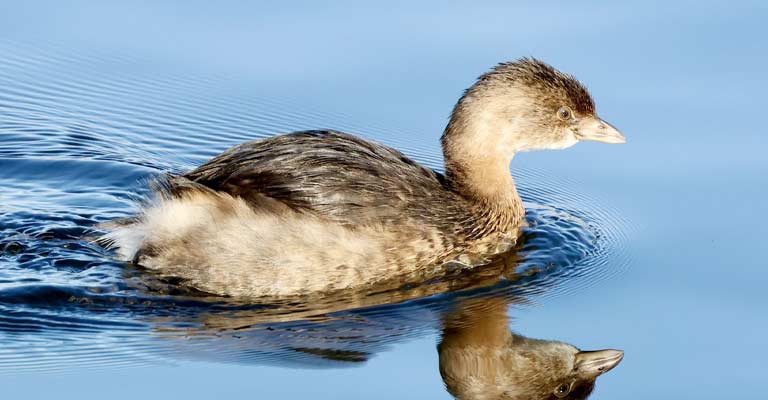
The Pied-billed Grebe is a compact bird with a stocky build, typically measuring around 12 to 15 inches in length.
Its body is streamlined, and it has a relatively short neck and a small head. This unique combination of features contributes to its distinctive appearance.
Plumage
During the breeding season, the Pied-billed Grebe exhibits a striking black ring around its bill, which is the primary characteristic giving the species its name.
Outside of the breeding season, this black ring may be less pronounced, and the bird’s overall plumage is brown with a mottled appearance, providing effective camouflage in its aquatic habitat.
Bill
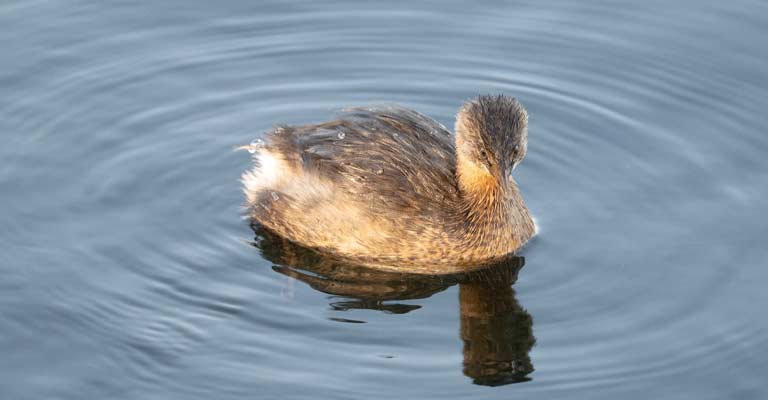
The most notable feature of the Pied-billed Grebe is its thick, stubby bill, which lacks the long, pointed shape common to many waterbirds. The bill is often paler at the base and becomes darker towards the tip.
During non-breeding periods, the black ring around the bill is less prominent, but the bill remains distinctive.
Eyes and Facial Features
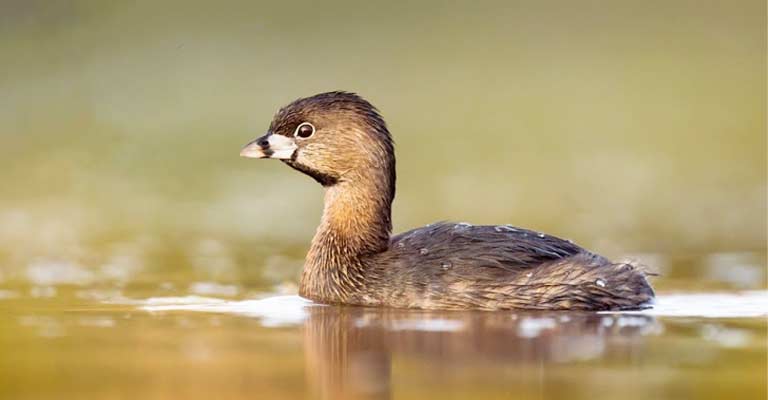
The bird has relatively large, dark eyes set within a facial pattern that lacks the prominent markings found in some other grebe species.
The face is usually plain, contributing to a more inconspicuous appearance.
Neck Position
Pied-billed Grebes tend to carry their necks in a slightly raised or hunched position while swimming, a behavior that sets them apart from some other waterbirds.
This characteristic can be particularly noticeable when observing their movements on the water.
Behavior
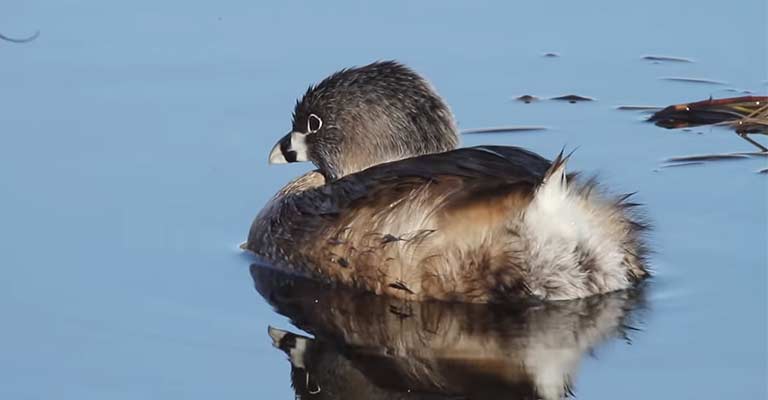
Pied-billed Grebes are skilled divers, using their strong legs and lobed toes to propel themselves underwater in search of prey, which primarily consists of small fish, insects, and aquatic invertebrates.
Their diving behavior and ability to disappear beneath the water’s surface are distinctive traits.
Vocalizations
The Pied-billed Grebe is known for its unique vocalizations. Their calls are varied and can include a series of whinnying, cackling, or ticking sounds.
Learning to recognize these vocalizations can be an additional aid in identifying this species.
The Pied-billed Grebe can be identified by a combination of physical characteristics, including its size, distinctive bill, plumage, and unique behaviors.
Observing these features in their natural habitat provides birdwatchers with a fulfilling opportunity to appreciate the remarkable adaptations of this fascinating waterbird.
Taxonomy of Pied-billed Grebe
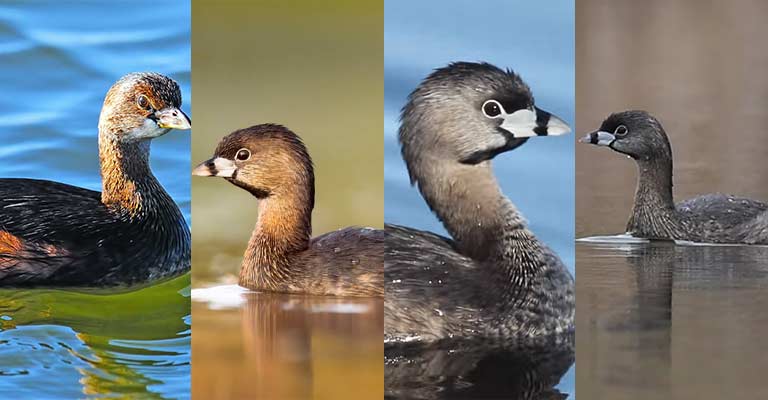
The table below will tell you everything about the taxonomy details of the Pied-billed Grebe:
| Taxonomic Rank | Classification |
| Domain | Eukaryota |
| Kingdom | Animalia |
| Phylum | Chordata |
| Class | Aves |
| Order | Podicipediformes |
| Family | Podicipedidae |
| Genus | Podilymbus |
| Species | P. podiceps |
The Pied-billed Grebe (Podilymbus podiceps) is a species exhibiting notable geographical variation, and its subspecies provide a fascinating insight into the diverse habitats they inhabit across the Americas.
- P. p. podiceps (Linnaeus, 1758): This subspecies is the nominal or original form found in North America, spanning from Canada to Panama. Inhabiting a vast range, these Pied-billed Grebes navigate the diverse climates and ecosystems found throughout the continent. Their adaptability allows them to thrive in northern breeding grounds as well as more temperate and warmer regions during migration.
- P. p. antarcticus (Lesson, 1842): The subspecies antarcticus occupies South America, extending from Colombia to central Chile and Argentina. These Pied-billed Grebes showcase adaptations to the southern reaches of the continent, demonstrating their ability to thrive in a variety of aquatic habitats, from the tropical zones to the more temperate climates of the Southern Cone.
- P. p. antillarum (Bangs, 1913): Found in the Greater and Lesser Antilles, the subspecies antillarum highlights the Pied-billed Grebe’s presence in the Caribbean islands. These birds navigate and adapt to the unique ecological conditions of these islands, which may include smaller bodies of water and specific vegetation characteristics.
Each subspecies of the Pied-billed Grebe has evolved to suit the environmental challenges and opportunities presented by its specific geographic range.
These variations in distribution and habitat preferences underscore the species’ adaptability, reflecting the Pied-billed Grebe’s capacity to thrive in a range of ecosystems from the Arctic to the southernmost regions of South America and the Caribbean.
Pied-billed Grebe Life History
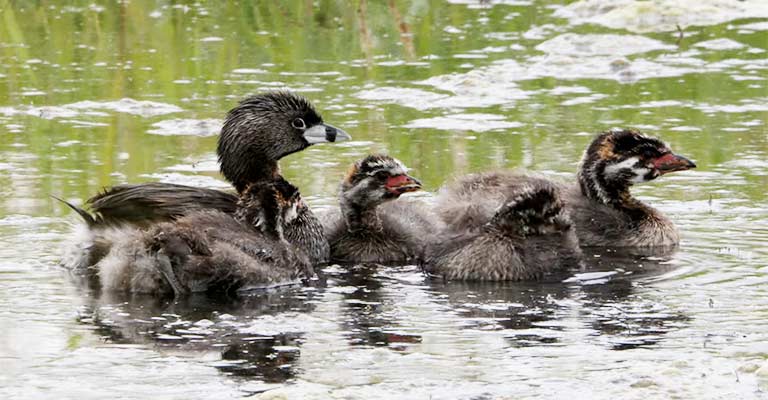
The Pied-billed Grebe (Podilymbus podiceps) is a fascinating waterbird with a rich life history, inhabiting a diverse range of aquatic environments across North and South America.
From its feeding habits to nesting behaviors, and efforts for conservation, exploring the various aspects of its life history sheds light on the intricate web of its existence.
Food
Pied-billed Grebes are skilled hunters, preying on a diet primarily composed of small fish, insects, and aquatic invertebrates.
Equipped with lobed toes and powerful legs, they excel at underwater foraging, diving beneath the surface to capture their prey.
Their adaptability allows them to adjust their diet based on seasonal and environmental variations, ensuring their survival in a variety of aquatic habitats.
Habitat
These grebes are versatile in their choice of habitat, thriving in ponds, lakes, marshes, and slow-moving rivers.
They display a preference for areas with abundant vegetation, utilizing their cryptic plumage to navigate through dense aquatic plants.
Their ability to adapt to different water conditions emphasizes their resilience in various ecosystems.
Range Map
The Pied-billed Grebe’s range spans a vast portion of the Americas, encompassing North, Central, and South America.
During the breeding season, they can be found in the northern reaches of their range, while they migrate to more temperate or warmer regions during the winter months.
A comprehensive range map illustrates their impressive migratory patterns and distribution across the continent.
Nesting
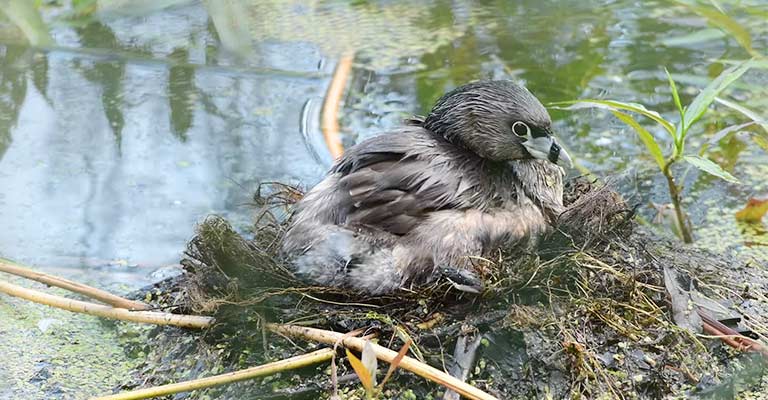
Nesting is a crucial aspect of the Pied-billed Grebe’s life history. These birds build floating nests, often anchored to emergent vegetation to protect them from predators.
Nests are constructed using plant materials, and both parents share the responsibilities of incubation and caring for the young.
Their reproductive strategy emphasizes adaptability to changing water levels and ensures the survival of the species in dynamic wetland environments.
Nesting Details of Pied-billed Grebe (Podilymbus podiceps)
| Aspect | Details |
| Clutch Size | Typically ranges from 3 to 10 eggs |
| Number of Broods | Often raises a single brood per breeding season |
| Egg Length | Approximately 2.1 to 2.4 inches (5.3 to 6.1 cm) |
| Egg Width | Approximately 1.5 to 1.8 inches (3.8 to 4.6 cm) |
| Incubation Period | Around 21 to 27 days, both parents contribute |
| Nestling Period | Chicks are precocial, and leave the nest soon after hatching |
| Egg Description | Pale to greenish, becoming stained over time; spherical |
| Nest Type | Floating platform nest constructed of aquatic vegetation |
| Nest Placement | Anchored to emergent vegetation in shallow water |
| Parental Care | Both parents involved in incubation and caring for the young |
| Fledgling Feathers | Downy feathers initially, later developing adult plumage |
| Nest Site Characteristics | Concealed among dense vegetation for protection |
The nesting details of the Pied-billed Grebe highlight its adaptive reproductive strategies, emphasizing the construction of floating nests in aquatic environments.
The parents invest significant effort in incubating the eggs and caring for the precocial chicks, showcasing their commitment to ensuring the survival of the next generation.
Diseases
While Pied-billed Grebes are generally hardy birds, they can be susceptible to various diseases.
Avian botulism, a bacterial disease, is one of the significant threats. This disease can result from the ingestion of toxins produced by bacteria in decaying organic matter.
Monitoring water quality and managing wetland habitats are essential in preventing the spread of such diseases.
Treatment
Efforts to treat and prevent diseases in Pied-billed Grebes involve a combination of habitat management, disease surveillance, and public awareness.
Conservation organizations work to monitor water quality, implement measures to reduce pollution and engage in research to better understand and combat diseases affecting these birds.
Rehabilitation centers also play a crucial role in treating individual birds affected by illness or injury.
Conservation
Conservation initiatives for the Pied-billed Grebe focus on protecting and restoring wetland habitats, managing water quality, and addressing potential threats such as habitat loss and pollution.
Collaborative efforts among conservation organizations, government agencies, and local communities are essential for ensuring the long-term survival of this species.
Public education and advocacy contribute to raising awareness about the importance of preserving wetlands, not only for the Pied-billed Grebe but also for the overall health of aquatic ecosystems.
The life history of the Pied-billed Grebe reflects its adaptability and resilience in diverse environments.
From feeding and nesting behaviors to challenges like diseases and conservation efforts, understanding these aspects contributes to the broader understanding of the intricate relationships between this waterbird and its environment.
Reproduction of Pied-billed Grebe
The Pied-billed Grebe (Podilymbus podiceps) engages in a distinctive reproductive process characterized by adaptability and parental cooperation.
During the breeding season, which varies geographically, these waterbirds construct floating nests anchored to emergent vegetation in shallow water. Clutch sizes typically range from 3 to 10 eggs.
Both male and female Pied-billed Grebes actively participate in incubating the eggs for approximately 21 to 27 days.
Once hatched, the chicks are precocial, leaving the nest soon after birth, though parental care continues.
The species often raises a single brood per breeding season. Nest sites are carefully chosen, and concealed among dense vegetation to provide protection.
This reproductive strategy underscores the Pied-billed Grebe’s resilience in diverse aquatic habitats and its commitment to ensuring the survival of its young in dynamic wetland environments.
Behavioral Habits of Pied-billed Grebe
The Pied-billed Grebe (Podilymbus podiceps) exhibits a repertoire of intriguing behavioral habits that contribute to its success as a waterbird.
Native to North and South America, this species showcases adaptability and distinctive behaviors in response to its aquatic habitat.
Diving and Foraging
One of the notable behavioral habits of the Pied-billed Grebe is its adept diving and foraging skills.
Equipped with lobed toes and powerful legs, these birds excel in underwater foraging, disappearing beneath the surface to capture small fish, insects, and aquatic invertebrates.
Their ability to navigate through dense vegetation and swiftly dive for prey underscores their specialization in hunting beneath the water’s surface.
Courtship Displays
During the breeding season, Pied-billed Grebes engage in elaborate courtship displays to establish pair bonds.
These displays involve a series of rituals, including head bobbing, mutual preening, and synchronized swimming. These intricate behaviors strengthen the pair’s connection and contribute to successful reproduction.
Vocalizations
Pied-billed Grebes are known for their diverse vocalizations, which play a crucial role in communication. Their calls range from whinnying and cackling sounds to distinct ticking noises.
These vocalizations serve various purposes, including mate attraction, territory defense, and communication between mates.
Parental Care
Nesting behaviors of Pied-billed Grebes are characterized by the construction of floating platforms anchored to emergent vegetation. Both male and female birds actively participate in nest-building, incubation, and caring for the young.
Their commitment to shared parental responsibilities ensures the survival of the offspring in the dynamic and sometimes challenging wetland environments they inhabit.
Territoriality
Pied-billed Grebes are territorial birds, especially during the breeding season. They defend their nesting territories with vocalizations and displays, signaling boundaries to other grebes and potential intruders.
This territorial behavior helps establish and maintain suitable nesting sites, contributing to successful reproduction.
The behavioral habits of the Pied-billed Grebe reflect its remarkable adaptations to aquatic life.
From proficient diving and foraging techniques to intricate courtship displays and vocalizations, these behaviors underscore the species’ resilience and success in a variety of wetland habitats across the Americas.
Wrapping Up
The pied-billed Grebe stands as a fascinating and resilient member of the avian world, capturing our admiration with its unique characteristics and behaviors.
From its distinct appearance, marked by the distinctive bicolored bill that gives the species its name, to its remarkable adaptability in diverse aquatic habitats, this bird showcases the marvels of evolution.
Exploring the Pied-billed Grebe’s lifestyle reveals a skilled swimmer and diver, navigating the waters with agility and stealth in search of prey.
Its ingenious strategy of building floating nests demonstrates a level of adaptability that is awe-inspiring.
As an indicator species for wetland health, the presence and behavior of the Pied-billed Grebe become crucial in understanding and conserving these vital ecosystems.